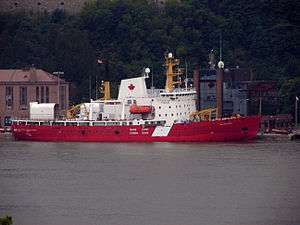CCGS Des Groseilliers
 | |
| History | |
|---|---|
| Name: | Des Groseilliers |
| Namesake: | Médard des Groseilliers |
| Operator: | Canadian Coast Guard |
| Port of registry: | Ottawa, Ontario |
| Builder: | Port Weller Drydocks Limited, St. Catharines, Ontario |
| Yard number: | 802160 |
| Commissioned: | 1982 |
| In service: | 1982-present |
| Refit: | 1996 |
| Homeport: | CCG Base Quebec, QC (Quebec Region) |
| Identification: | CGDX |
| Status: | in active service |
| General characteristics | |
| Class and type: | T1200-class medium Arctic icebreaker |
| Tonnage: | 6,097.8 GT |
| Length: | 98.24 m (322 ft 4 in) |
| Beam: | 19.84 m (65 ft 1 in) |
| Draft: | 7.44 m (24 ft 5 in) |
| Ice class: | 100 A (Arctic Class 2-3) |
| Propulsion: | Diesel electric - 6 Bombardier M251F-16v9 |
| Speed: | 16.5 knots (30.6 km/h) |
| Range: | 30,600 nmi (56,700 km) |
| Endurance: | 108 days |
| Complement: | 38 (12 officers, 26 crew) |
| Sensors and processing systems: |
|
| Aircraft carried: | 1 × MBB Bo 105 helicopter |
| Aviation facilities: | Hangar |
CCGS Des Groseilliers is a T1200-class medium Arctic icebreaker in the Canadian Coast Guard.[1] The vessel is named after Médard Chouart Des Groseilliers (1618-1669) a close associate of Pierre-Esprit Radisson in explorations west of the Great Lakes and the founding of the English Hudson's Bay Company. The vessel has participated in a number of research voyages, including Ice Station SHEBA.[2] As part of the Surface Heat Budget of the Arctic Ocean experiment conducted in the Arctic Ocean from October 1997 to October 1998 to provide polar input to global climate models, Des Groseilliers was allowed to be frozen into the ice for the Arctic winter, to serve as a base for scientific researchers.
In spring 2008, Des Groseilliers collided with the Sea Shepherd Conservation Society vessel, Farley Mowat, in the Gulf of Saint Lawrence, during the annual seal hunt. Paul Watson, head of the society, claimed that the icebreaker had rammed the society's research vessel. However, a spokesman for the department of Fisheries and Oceans Canada claimed that the research vessel "grazed" the icebreaker.[3]

See also
- CCGS D'Iberville - icebreaker joined Des Groseilliers a year prior to retirement
References
- ↑ Canadian Coast Guard (2010-07-26), Icebreaking Program—The Icebreaking Fleet
- ↑ Perovich, Donald; Moritz, Richard C.; Weatherly, John (2003), SHEBA: The Surface Heat Budget of the Arctic Ocean (PDF) (03048 ed.), National Science Foundation
- ↑ "Sea Shepherd and coast guard ships collide", Sydney (Australia) Morning Herald, Associated Press, April 1, 2008, retrieved 2011-01-12